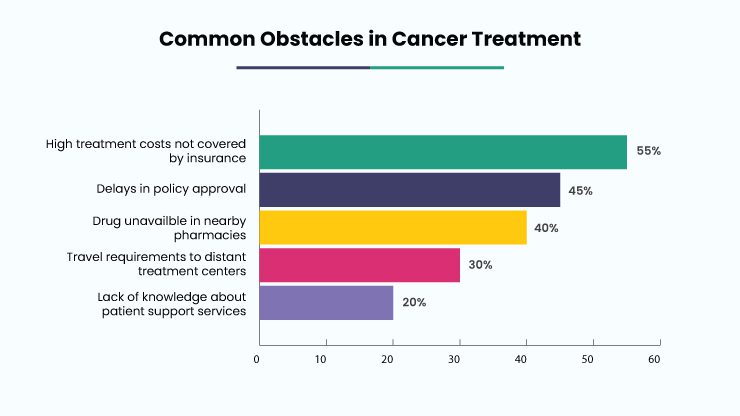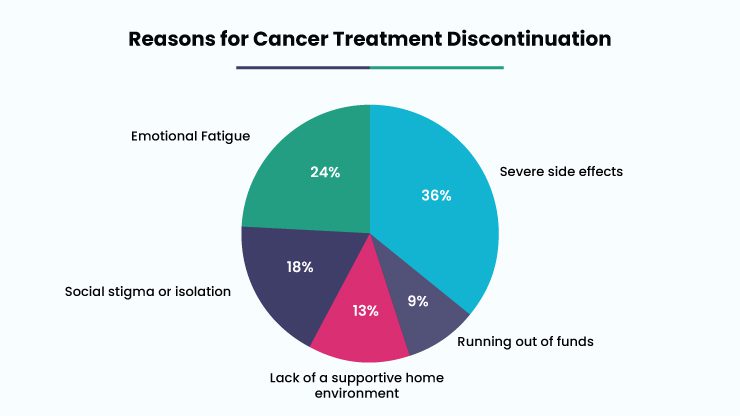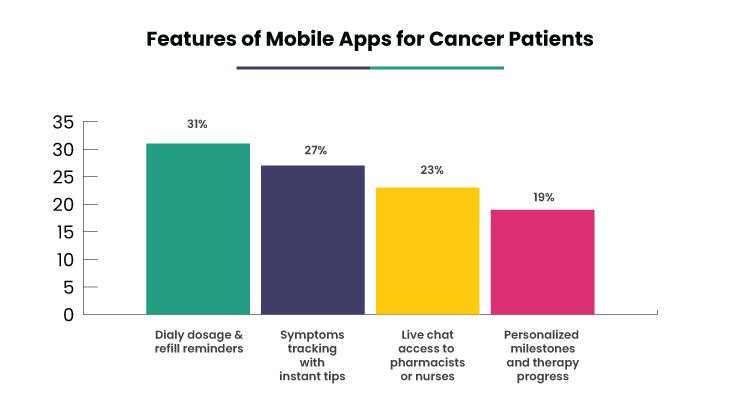Introduction
In cancer care, success isn’t solely defined by writing a prescription- it is defined by whether patients can begin treatment and stick with it. Unfortunately, many individuals, particularly those in underserved or rural areas, face complex barriers that prevent them from initiating or completing their treatment. Challenges such as long insurance approvals, unaffordable out-of-pocket expenses, remote locations, and psychological stress often disrupt the patient’s journey.
For pharmaceutical brand leaders, it’s time to shift the spotlight. Beyond traditional marketing efforts, the opportunity now lies in becoming a vital part of the patient’s care journey- facilitating access, ensuring treatment continuity, and offering consistent support throughout.
“When patients fall off treatment due to barriers that were avoidable, we as a system have failed.”
-Dr. Isha Naik, Consultant Oncologist
Rethinking Access in Cancer Treatment
Even when oncologists recommend the most effective therapies, patients frequently encounter problems that delay or prevent treatment. Some common obstacles include:
- High treatment costs not covered by insurance
- Delays in policy approvals
- Drug unavailability in nearby pharmacies
- Travel requirements to distant treatment centers
- Lack of knowledge about patient support services
When these access points break down, patients may suffer worse clinical outcomes. For pharmaceutical teams, improving access is not a courtesy- it’s a necessity that directly influences trust, loyalty, and patient results.

How Pharma Can Enable Access
1. Financial Support Programs
Pharmaceutical companies can play a significant role in affordability through initiatives such as:
- Income-based pricing tiers
- Subsidized co-pay schemes
- Easy installment options for therapy costs
- Dedicated helplines to assist with claims and reimbursements
In regions like South Asia or Sub-Saharan Africa, such efforts have made advanced cancer medications available to families who otherwise had no viable options.
2. Logistical Assistance
Many patients encounter practical issues beyond cost. Pharma can collaborate to provide:
- Travel reimbursement or transport coordination to treatment centers
- Home delivery of oral or injectable drugs
- Scheduling assistance for consultations or infusions
- Liaison with hospitals for synchronized treatment timing
These services not only improve adherence but also reduce patient and caregiver stress.
3. Local Market Adaptation
Reaching smaller towns and rural regions calls for context-aware strategies, such as:
- Stocking products through regional hospital partners
- Supporting smaller satellite oncology clinics
- Educating local healthcare workers on cancer basics
- Publishing treatment guides in local languages
Customizing programs based on geographic and cultural needs strengthens brand credibility and deepens patient connection.
Beyond Access: Supporting Adherence for Better Outcomes
Once access is secured, keeping patients engaged throughout long, physically and emotionally draining treatment cycles becomes the next major challenge. Patients often discontinue therapy due to:
- Severe side effects
- Emotional fatigue
- Social stigma or isolation
- Lack of a supportive home environment
- Running out of funds during ongoing treatment
Pharma can intervene with systems that encourage continuation, promote emotional resilience, and maintain treatment clarity.

Adherence Tools: Blending Tech with Human Support
1. Mobile Apps and Smart Alerts
Mobile-based platforms have demonstrated effectiveness in keeping patients consistent. These tools can provide:
- Daily dosage and refill reminders
- Symptom tracking with instant tips
- Live chat access to pharmacists or nurses
- Personalized milestones and therapy progress
Apps tailored by cancer type can offer timely, relevant, and comforting content during therapy.

2. Informational and Wellness Resources
Patients often need continuous support for side-effect management. Useful tools include:
- Practical tips for managing nausea, pain, and fatigue
- Diet plans and hydration tracking
- Home care guidance to prevent infections
- Exercises and mental health check-ins
Developing these materials in collaboration with patient advocacy groups and translating them into regional languages improves accessibility and usability.
Supporting the Caregiver Network
Behind every cancer patient is usually a caregiver facing equal, if not greater, emotional and logistical strain. Pharma can support them through:
- Simple guides for administering medications
- Symptom red-flag checklists
- Burnout helplines for mental health support
- Access to support groups or caregiver communities
When caregivers are better informed and supported, patients benefit from more consistent and safe care.
Data Empowerment for Physicians
Physicians may not always know when a patient stops taking medication or skips a dose. Pharma can help bridge this gap by sharing insights from their support programs:
- Aggregated reports showing adherence trends
- Real-time notifications for missed drug deliveries
- Dashboards with anonymized patient behavior data
With this data, healthcare providers can adjust care plans early, address emerging problems, and prevent avoidable dropouts.
A Real-World Example of Adherence Innovation
A regional pharmaceutical company launched a program for a newly approved oral cancer medication, combining:
- Sensor-equipped blister packs to track medication intake
- SMS reminders for patients and caregivers
- Monthly check-ins with oncology-certified nurses
- Audio content sharing survivor experiences
- Weekly wellness checklists through WhatsApp
After six months, the program saw:
- 33% rise in treatment completion
- 27% fewer hospital emergencies
- Increased satisfaction from both patients and doctors
This case illustrates that smart, empathetic adherence strategies are not just beneficial they are a long-term investment in brand value and patient outcomes.
Reimagining the Field Force Role
Sales and medical reps must evolve beyond the clinical pitch. Their new role should include:
- Guiding clinics on how to enrol patients into support services
- Distributing starter packs or app access codes
- Gathering patient and clinician feedback for continuous improvement
- Sharing field insights with brand and support teams
Every brand interaction should reflect a deep commitment to the complete patient journey not just the moment of prescription.
From Product Seller to Healthcare Partner
In cancer care, brand trust is built not by flashy promotion but by meaningful support. Companies that proactively assist patients through challenges are viewed as long-term partners.
“When help goes beyond the pill, we start to see pharma as collaborators, not vendors.”
– Dr. Aniruddh Banerjee, Hemato-Oncologist
By actively eliminating access and adherence barriers, pharma brands don’t just gain goodwill- they achieve real-world differentiation and improved clinical impact.
The Next Frontier: Personalized, Predictive Support
New technologies offer tools for more proactive and individualized patient care:
- Predictive algorithms to flag high-risk patients
- Custom behavioral nudges based on therapy patterns
- Multilingual chatbots for around-the-clock Q&A
- Emotional health surveys that trigger real-time counseling
With regulatory approval and ethical oversight, these tools can help pharma play a more dynamic, patient-first role.
Conclusion: From Transactional to Transformational
Pharmaceutical brand managers in oncology must expand their perspective—from focusing on prescriptions to championing patient success. Overcoming barriers to access and boosting adherence are no longer optional—they are essential for therapeutic success.
By combining empathy, technology, and smart logistics, pharma can genuinely walk alongside patients and care teams, shaping better outcomes and stronger brands.



